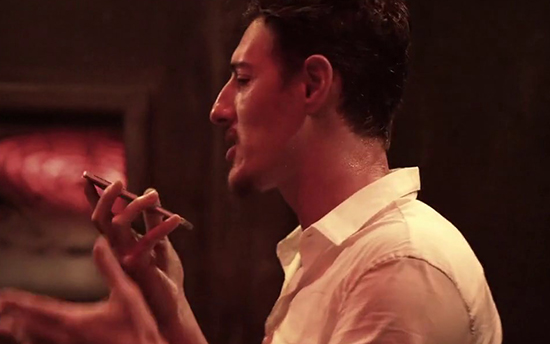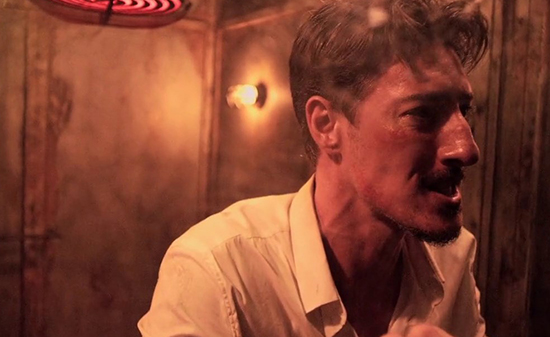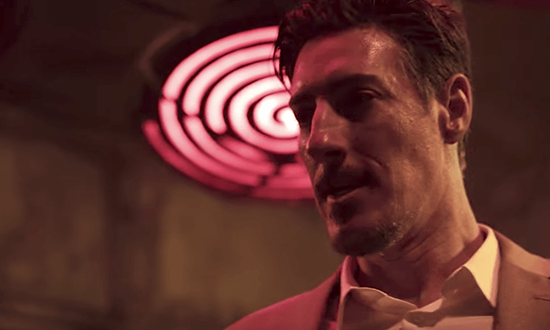SYNOPSIS:
Ryan Hinds awakes inside a sealed industrial kiln. He is sent challenges by a voice with no face, pushed to the limits of human endurance as the temperature within the kiln begins to rise.
REVIEW:
I’m not a particular fan of the 2004 movie Saw (technically well made but relentlessly cold and nihilistic) and I find distinctly risible the torture porn subgenre that has become the rage since. However, there is a kind of splinter level, sub-subgenre that kind of sprung out from that film’s seed that draws my interest as much for its avant-garde experimental theater tone as any cinematic qualities. That is having one central character/protagonist wake up from a state of unconsciousness to find they are trapped inside some small space (a room, a box etc.) and are completely unaware of how they came to be there.
The methodology of torture within this structure can variate. Sometimes there’s ominous voice of a tormenter over a speaker system or on a cell phone. Other times, a simple but carefully unfurled plot exposition reveals how the person came to their dire situation. There’s usually a mechanical construct somewhere near that can be set and activated to cause extreme physical torture of some kind (scorching heat, freezing cold, a poisonous gas to be inhaled etc.). This formula often involves a single set from which to film and a very small cast with one central lead for 95 percent of the runtime and a handful of other performers in small bits inserted at key points to break any possible monotony. Having a camera focused on just one character in one room for ninety minutes or so, while no doubt being an actor’s dream showcase, can be sleep-inducing for viewers if the story even slightly fails to compel and the star fails to exude the necessary charisma to keep eyes glued to the screen. Fortunately, Giorgio Serafini’s 200 Degrees, while not to the extreme minimalist level of Ryan Reynolds trapped in a coffin in 2010’s Buried, is still that rarity of bare bones minimalism with just enough colorful dialogue and twists in the script supporting a magnetic lead performance for one riveting experience.
Investment broker Ryan Hinds wakes inside an industrial kiln with no knowledge of how he got there. A voice over a speaker system proclaims he will activate the heating unit in the kiln gradually to 200 degrees and cook Hinds to death unless he delivers one million dollars to the tormenter within 2 hours. But is the psycho just after money or something more? And is Hinds really who he says he is? A cat and mouse game ensues with the clock ticking on the young businessman.
Serafini relies more on the suggestion of something horrible happening, or a description of it, rather than showing overt kill scenes and gore. In fact, the only visible blood in the film comes in one scene with a dismembered finger and a pair of squib bits in the finale. And gross out effects are not missed at all. There’s no question that the director was influenced by great horror helmers like Terence Fisher, Alfred Hitchcock, and even a Val Lewton from cinema’s golden age when it comes to the art of using verbal depiction to stoke the moviegoer’s imagination rather than using a gratuitous visual.
Truly Serafini seems more intrigued with the antagonist finding the inner demons in the victim and playing on them to get his answers than with committing the slice and dice act. I also think the stone and steel kiln set piece is an inspired locale for enacting this dark, bleak tale. The camera goes over every corner, crack and vent in the place as if providing a suitably depressing frame for this grim picture on display. Using the heating grills as weapons is a nice trick, too, as all that’s needed for the scene is a light visual and water sprayed on the skin and let the actor’s escalating hysteria do the rest.
The lead who is being put through the ringer here is of the familiar face variety rather than someone widely-known, a gifted artist named Eric Balfour. A shame that Balfour is not a star as yet as he has that classic movie star look and magnetism. I became a fan seeing his co-starring role as CTU agent Milo Pressman on season 6 of 24. With his high cheekbones, slightly aquiline nose, piercing eyes and internalized emotional energy, Balfour is something of a joy to watch as he unravels from the intense pressures brought by his captor. I could imagine this film being shown to acting class students as a prime example of how to use voice and expression to grip your audience.
Fans who seek extensive bloodletting and visuals mixed in with their fables involving forced self-masochism may want to avoid 200 Degrees. But if you appreciate performance and dialogue over look and seek a piece that invites you and your imagination to play along, 200 Degrees definitely fills the bill while bringing the heat!
 Horror News | HNN Official Site | Horror Movies,Trailers, Reviews
Horror News | HNN Official Site | Horror Movies,Trailers, Reviews
















